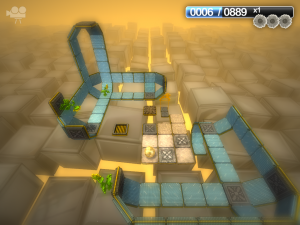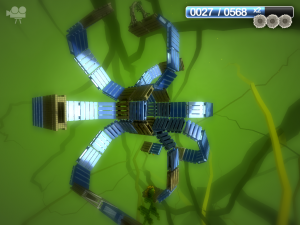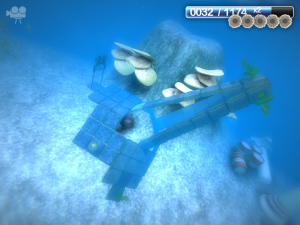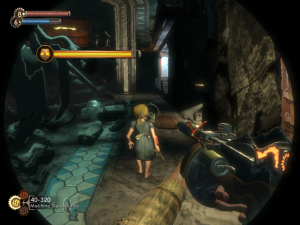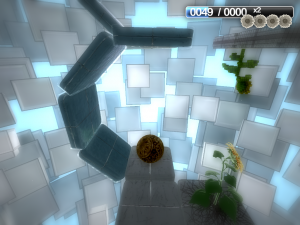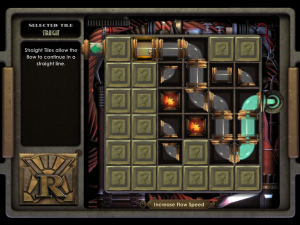Posting this a couple days late. I finally got up to (and substantially past) the point of long-anticipated revelations. So let’s talk plot, in a spoilery way.
But first, to provide a buffer for for those not wanting spoilers, let’s talk a bit about the function of revelations in a game. Mainly they give some shape to an experience that might otherwise feel homogeneous: instead of spending six hours shooting bad guys, for example, you spend four hours shooting bad guys while confused and seeking answers followed by two hours shooting bad guys with firm and definite purpose. Alternately, new facts can justify sudden changes in gameplay — learning the bad guys’ motivations, for example, could lead to fighting on their side. Bioshock has a little of both sorts. There’s a third sort I think I should mention, because I feel like I’ve been mentioning it a lot lately, what with all the horror games in this year’s IF Comp: the revelation of something that the player already knows but the player character doesn’t, usually something that’s going to make life awful for the protagonist once he knows it and which therefore excites tragic sympathy. (I suppose that the “My god, what is that thing?” moment is also an example of this, albeit a very clumsy one.) Bioshock is something of a horror game and something of a tragedy, but it doesn’t quite do this, or at least not for me: when I speak of long-anticipated revelations, I don’t mean that I knew in advance what the revelations were going to be. I just knew there were going to be revelations.
There are really two twists delivered nearly simultaneously: the truth about Atlas, and the truth about the player character. Like I said before, I was suspicious of Atlas the moment he started being helpful, and his callousness towards the Little Sisters made me even moreso, so I was pretty sure he was hiding something, but I didn’t know what. I had some baseless guesses — was he a pseudonym of Andrew Ryan, allowing him to play both sides? A Big Daddy that overcame its conditioning? I suppose someone cleverer than myself could have figured out the truth: you hear quite a lot about Frank Fontaine, about how he was a crime boss who wielded illegitimate control over Rapture by controlling the Adam supply until Ryan’s men killed him, shortly before Atlas came along and started his uprising. The thing is, the level where you start hearing about Fontaine is also the level where you start hearing about Ryan rounding up dissidents and imposing the death penalty in complete contradiction to his stated ideals (with the usual mealy-mouthed excuses you hear from any dictator). And not just dissidents, but smugglers. Smugglers, in a free-trade paradise? It doesn’t take long to learn (and be repeatedly, anviliciously reminded) that the contraband they were smuggling consisted of literature and other media considered dangerous to Rapture society, mainly Bibles. So Ryan comes off as simply power-hungry and paranoid, and it’s easy to draw the conclusion that Fontaine is just someone who he demonized because he didn’t want to share power, and probably fundamentally blameless. It didn’t even occur to me that he actually is the fulfillment of Ryan’s paranoid fantasies, a con man playing the public for saps, and devious enough to fake his own death and come back with an even better con when it all went bust. But now that he’s come clean and become my enemy, he’s positively determined to prove Ryan right, to make Rapture’s collapse into the effect of an evil outside influence rather than the inevitable result of its intrinsic flaws. It’s a conclusion that’s morally uncomfortable in roughly the same way as the documents released in the 1990s showing that there actually had been Soviet infiltration of the State Department when McCarthy said there was: some people are so wrong in their actions, you don’t want them to turn out to be right about anything. I have to remind myself that Andrew Ryan is still enough of a monster that he’d rather destroy Rapture’s oxygen supply than allow the city to fall into the hands of, well, anyone without his permission — that he once burned down a forest to keep it from being turned into a public park — that, indeed, he’s become the sort of Kurtz-like madman who hangs corpses on hooks outside his office as a warning to others.
The revelations about the player character, now. Every once in a while, throughout the game, you get flashes of memory, in the form of sepia photographs of unclear significance: a farmhouse, a small group of people — the PC and his parents, perhaps? Not entirely clear: they flash by too fast for you get a good look. But the flashes are accompanied by ominous sound effects, sometimes by distant screaming, which I think is generally horror-game shorthand for suppressed knowledge. So, as in those horror games I mentioned earlier, it was clear that there was some dire revelation brewing, but unlike most such situations, it wasn’t at all clear what it was going to be. Some connection to Rapture, I presumed — perhaps the plane crash somehow wasn’t an accident. I was righter than I suspected: the PC’s connection to Rapture is that he was genetically engineered in Rapture, grown to adulthood in a matter of hours and had false memories implanted in Rapture, for the specific purpose of a mission in Rapture. Apparently the command phrase “Would you kindly”, used frequently by Atlas in his communications, activates the PC’s mental conditioning, giving him commands that he can’t help but obey — which is to say, your mission objectives throughout the game. This is one of those things that makes me want to go back and play through the game again, or at least to review the messages available from within the game’s info menus, to hear all the dialogue with knowledge of what it really means. Did Sasha Cohen use the phrase, during the brief time when he took over as taskmaster? Did Atlas say it when telling me to kill the Little Sisters, the one order of his that I’ve disobeyed? When exactly did Andrew Ryan figure out what I was? For it’s Ryan who tells you the truth, when you finally confront him. He definitely starts off at least as clueless as the player: the first time he contacts you by radio, he asks if you’re CIA or KGB. But as you approach his lair, he makes comments about how you’re “not fully human”, which seemed at the time to simply be part of his free-men-vs-parasites rhetoric.
Shortly after this revelation, Dr. Tenenbaum removes the “Will you kindly” trigger, making it impossible for Fontaine to clean up loose ends just by saying “Will you kindly commit suicide”. He does activate some other failsafes that mix up the gameplay a bit, lowering your maximum health, and then, when you attempt to undo that, temporarily putting you into an unsettled state where you can’t control what plasmid you’re using at any given moment, changing it at random. (The game can even choose plasmids you haven’t purchased, which I suppose is a bug, but it’s also a nice way to give the player experience of stuff that might otherwise go unseen.) The funny thing is how little really changes. The trigger phrase was essentially an in-fiction justification for why tasks assigned to you by strangers are mandatory, and in particular for why you have to kill Ryan instead of just sitting down and talking to him. But even without the phrase, the rules of the game demand that you get your marching orders from someone — it just shifts that role from Atlas to Tenenbaum. “A man decides, a slave obeys”: Ryan repeats this several times in his final spiel. By that standard, the player is still a slave.
Speaking of in-game justifications, the game tries to use the same revelations to sell everything else that’s implausible about your success so far. You can face incredible odds and kill Big Daddies so much more easily than the locals (who certainly try) because you were designed to be a killing machine. You can bypass the security systems so easily because Andrew Ryan left genetically-keyed back doors for himself, and you were created using his DNA. Actually, at one point it’s stated that you have half his DNA, which suggests that the PC may not be just a vat-grown homunculus, but Ryan’s natural son (modulo enhancements and rapid growth). This would explain why Diane McClintock, Ryan’s girlfriend, remains such a major source of audio logs throughout the game, despite being such a minor figure in Rapture and in the story so far: she’s probably the PC’s mother. I’m getting ahead of myself here, mind you; I still have a couple of levels to go. But it’s nice to finally have a revelation that I’m anticipating.
 Comments(1)
Comments(1)